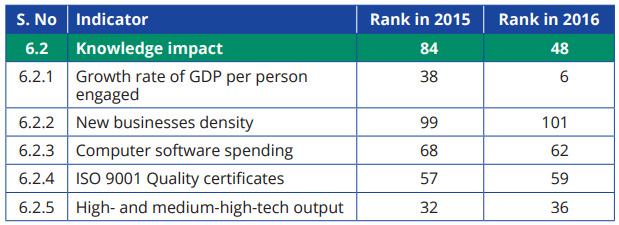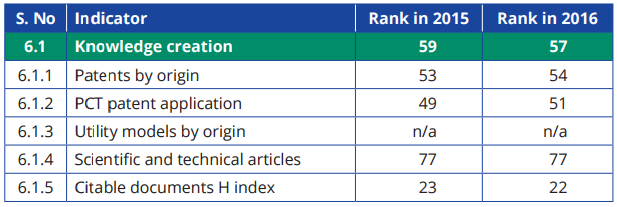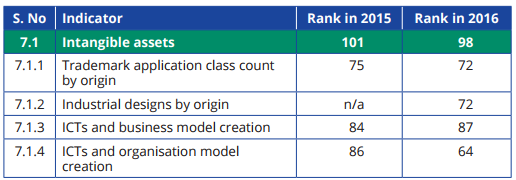India’s rise in the Global innovation index ranking

The Global Innovation Index (GII) released the Global Innovation Index 2017 in June 15, 2017, in which India stood at the 66th rank. The GII 2017 lists 127 countries according to various aspects that are responsible for innovation. It is co-published by Cornell University (New York), INSEAD graduate business school (France), and the World Intellectual Property Organization (WIPO, an agency of the United Nations).
The GII focuses on innovation and uses a broad variety of information and sources for capturing data to develop the Index. The GII collates information related to seven sub-indexes, which comprises five input indexes and two output indexes. The five input indexes are: (1) Institutions, (2) Human capital and research, (3) Infrastructure, (4) Market sophistication, and (5) Business sophistication. The two output indexes that capture actual evidence of innovation outputs are (6) Knowledge and technology outputs and (7) Creative outputs.
India’s Department of Industrial policy and Promotion (DIPP) set up a ‘Task Force on Innovation’ which was tasked with assessing innovation creation and suggesting measures to enhance the innovation ecosystem in India in order to improve India’s GII ranking. The Task Force comprises government officials and experts from private organisations and academia. This team published an in-depth report after studying the Global Innovation Index 2017. The report compares rankings from 2015 and 2016, giving a clear-cut picture of how we have progressed in this time duration, and provides recommendations of various schemes and plans that can be implemented.
In particular, the output index ‘knowledge and technology outputs’ includes several indicators belonging to Intellectual Property. The ‘knowledge and technology outputs’ index comprises three sub-pillars, namely Knowledge creation, Knowledge impact and Knowledge diffusion, resulting in fourteen individual indicators altogether. The following tables showcase our rankings based on data collected in 2015 and 2016 (the GII 2017 report ranks nations based on 2016 data).
We witnessed an improvement in the ranking of the knowledge and technology outputs index. 2016 saw an overall improvement in all three segments, and a particularly commendable improvement seen in the knowledge impact indicators, wherein our rankings rose by 36 ranks.
The knowledge creation sector did not see much of a rise in rankings. Further, it is worth noting that while the ranking for ‘Scientific and technical articles/ bn PPP$ GDP’ has remained the same, the score for the same has decreased from 7.5 to 7. The report mentions Uchchatar Avishkar Yojana (UAY) and Impacting Research, Innovation, and Technology (IMPRINT), both of which are Government programs that may aide intellectual property creation.
Further suggestions stress on the importance of improving the availability and quality of education. There needs to be a focus on higher education, namely graduate programs and higher programs, while stressing upon research in fundamental as well as applied knowledge.
Another point to note here is that these indicators only capture data created by formal systems. However, there are numerous innovations occurring informally, at various levels. There is a requirement for a bridge linking formal knowledge as well as informal. Including this informal, unaccounted data would greatly benefit the Government as well as the people, along with increasing our rankings in this area.
Knowledge impact
The knowledge impact sector witnessed a considerable rise in rankings from the 84th rank in 2015 to the 48th rank in 2016. The major cause for this is the increase in rankings of ‘Growth rate of GDP per person engaged (constant 1990 PPP$)’ from the 38th rank to the 6th rank in the world.
 In case of knowledge impact, there is a need to create awareness on various opportunities available through the State and Central government. Proper knowledge must be imparted to the public with respect to any available benefits and schemes so that interested people or organizations may put them to good use.
In case of knowledge impact, there is a need to create awareness on various opportunities available through the State and Central government. Proper knowledge must be imparted to the public with respect to any available benefits and schemes so that interested people or organizations may put them to good use.
The report also mentions that programs and initiatives like Make in India, Start Up India, Smart Cities across the country, Industrial Corridor etc. would give a positive impact to the GDP growth in India.
Knowledge diffusion
The improvement in the knowledge diffusion sector was driven mainly by the ‘FDI net outflows, % GDP’, which saw a rise in ranking from the 92nd rank to the 60th rank. FDI net outflows is defined as the “net outflows of investment to acquire a lasting management interest (10% or more of voting stock) in an enterprise operating in an economy other than that of the investor.” It is also important to note we rank 1st in the world for ICT (Information and Communication Technologies) services exports, which was retained from 2015.
There is definitely a need for increasing a general awareness of IP among the public. Such awareness is especially required among Micro, Small & Medium Enterprises (MSMEs), since they are creating innovation but aren’t protecting it or utilising existing IP laws to gain the best benefits possible. IP protection in India must be improved.
Another indicator that concerns IP can be found in the ‘Creative outputs’ index, in which India’s rank improved by 1 from a ranking of 95th in 2015 to a ranking of 94th in 2016.
In particular, the ‘intangible assets’ sector concerns trademark applications and industrial designs, as shown below.
An increase in awareness regarding the identification, recognition and registration of trademarks and industrial designs among public, start-ups and MSMEs must be implemented. Further, Intellectual Property Facilitation Centres (IPFCs) should be strengthened and further replicated in all the districts; IP Cells need to be established in all Universities in India. This can result in higher IP filings that result in an improvement of our ranking in these sectors.
Overall, India witnessed a commendable rise in the Global Innovation Index Rankings, jumping from the 81st rank in 2015 to the 66th rank in 2016. The GII-2017 report states, “India is a good example of how policy is improving the innovation environment”. Schemes such as Start-up India, IMPRINT, UAY, Make in India and Industrial corridor, among many others, provide an encouraging view on improving innovation and industry. We hope that with the proper planning and implementation of such schemes, India may finally live up to its potential for Intellectual Property.
We hope this article was a useful read.
Please feel free check our services page to find out if we can cater to your requirements. You can also contact us to explore the option of working together.
Best regards – Team InvnTree
This work is licensed under a Creative Commons Attribution-NonCommercial 3.0 Unported License

 Follow
Follow








Leave a Reply